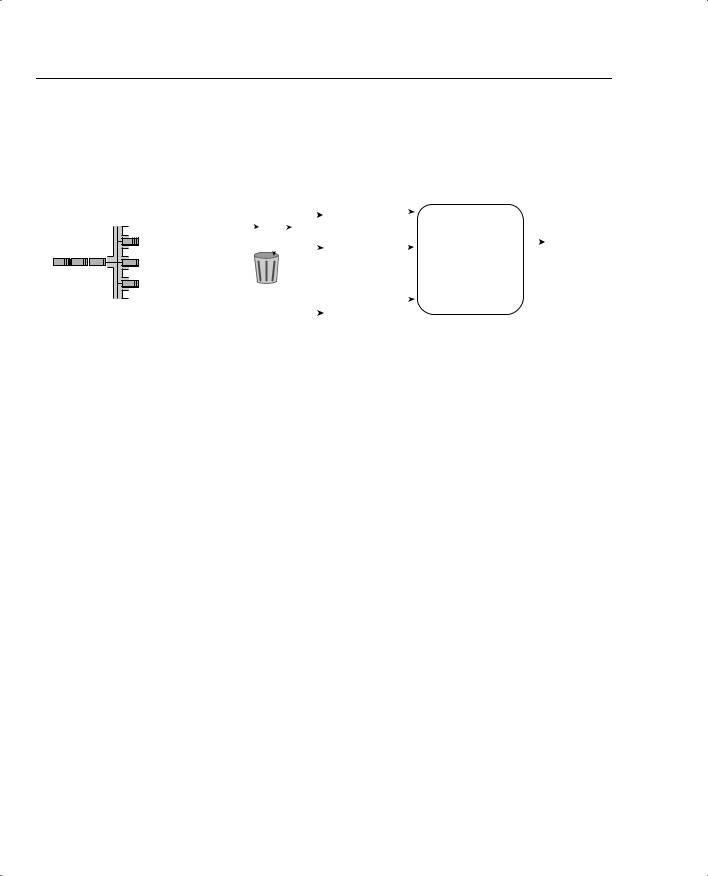
- •QoS Overview
- •“Do I Know This Already?” Quiz
- •QoS: Tuning Bandwidth, Delay, Jitter, and Loss Questions
- •Foundation Topics
- •QoS: Tuning Bandwidth, Delay, Jitter, and Loss
- •Bandwidth
- •The clock rate Command Versus the bandwidth Command
- •QoS Tools That Affect Bandwidth
- •Delay
- •Serialization Delay
- •Propagation Delay
- •Queuing Delay
- •Forwarding Delay
- •Shaping Delay
- •Network Delay
- •Delay Summary
- •QoS Tools That Affect Delay
- •Jitter
- •QoS Tools That Affect Jitter
- •Loss
- •QoS Tools That Affect Loss
- •Summary: QoS Characteristics: Bandwidth, Delay, Jitter, and Loss
- •Voice Basics
- •Voice Bandwidth Considerations
- •Voice Delay Considerations
- •Voice Jitter Considerations
- •Voice Loss Considerations
- •Video Basics
- •Video Bandwidth Considerations
- •Video Delay Considerations
- •Video Jitter Considerations
- •Video Loss Considerations
- •Comparing Voice and Video: Summary
- •IP Data Basics
- •Data Bandwidth Considerations
- •Data Delay Considerations
- •Data Jitter Considerations
- •Data Loss Considerations
- •Comparing Voice, Video, and Data: Summary
- •Foundation Summary
- •QoS Tools and Architectures
- •“Do I Know This Already?” Quiz
- •QoS Tools Questions
- •Differentiated Services Questions
- •Integrated Services Questions
- •Foundation Topics
- •Introduction to IOS QoS Tools
- •Queuing
- •Queuing Tools
- •Shaping and Policing
- •Shaping and Policing Tools
- •Congestion Avoidance
- •Congestion-Avoidance Tools
- •Call Admission Control and RSVP
- •CAC Tools
- •Management Tools
- •Summary
- •The Good-Old Common Sense QoS Model
- •GOCS Flow-Based QoS
- •GOCS Class-Based QoS
- •The Differentiated Services QoS Model
- •DiffServ Per-Hop Behaviors
- •The Class Selector PHB and DSCP Values
- •The Assured Forwarding PHB and DSCP Values
- •The Expedited Forwarding PHB and DSCP Values
- •The Integrated Services QoS Model
- •Foundation Summary
- •“Do I Know This Already?” Quiz Questions
- •CAR, PBR, and CB Marking Questions
- •Foundation Topics
- •Marking
- •IP Header QoS Fields: Precedence and DSCP
- •LAN Class of Service (CoS)
- •Other Marking Fields
- •Summary of Marking Fields
- •Class-Based Marking (CB Marking)
- •Network-Based Application Recognition (NBAR)
- •CB Marking show Commands
- •CB Marking Summary
- •Committed Access Rate (CAR)
- •CAR Marking Summary
- •Policy-Based Routing (PBR)
- •PBR Marking Summary
- •VoIP Dial Peer
- •VoIP Dial-Peer Summary
- •Foundation Summary
- •Congestion Management
- •“Do I Know This Already?” Quiz
- •Queuing Concepts Questions
- •WFQ and IP RTP Priority Questions
- •CBWFQ and LLQ Questions
- •Comparing Queuing Options Questions
- •Foundation Topics
- •Queuing Concepts
- •Output Queues, TX Rings, and TX Queues
- •Queuing on Interfaces Versus Subinterfaces and Virtual Circuits (VCs)
- •Summary of Queuing Concepts
- •Queuing Tools
- •FIFO Queuing
- •Priority Queuing
- •Custom Queuing
- •Weighted Fair Queuing (WFQ)
- •WFQ Scheduler: The Net Effect
- •WFQ Scheduling: The Process
- •WFQ Drop Policy, Number of Queues, and Queue Lengths
- •WFQ Summary
- •Class-Based WFQ (CBWFQ)
- •CBWFQ Summary
- •Low Latency Queuing (LLQ)
- •LLQ with More Than One Priority Queue
- •IP RTP Priority
- •Summary of Queuing Tool Features
- •Foundation Summary
- •Conceptual Questions
- •Priority Queuing and Custom Queuing
- •CBWFQ, LLQ, IP RTP Priority
- •Comparing Queuing Tool Options
- •“Do I Know This Already?” Quiz
- •Shaping and Policing Concepts Questions
- •Policing with CAR and CB Policer Questions
- •Shaping with FRTS, GTS, DTS, and CB Shaping
- •Foundation Topics
- •When and Where to Use Shaping and Policing
- •How Shaping Works
- •Where to Shape: Interfaces, Subinterfaces, and VCs
- •How Policing Works
- •CAR Internals
- •CB Policing Internals
- •Policing, but Not Discarding
- •Foundation Summary
- •Shaping and Policing Concepts
- •“Do I Know This Already?” Quiz
- •Congestion-Avoidance Concepts and RED Questions
- •WRED Questions
- •FRED Questions
- •Foundation Topics
- •TCP and UDP Reactions to Packet Loss
- •Tail Drop, Global Synchronization, and TCP Starvation
- •Random Early Detection (RED)
- •Weighted RED (WRED)
- •How WRED Weights Packets
- •WRED and Queuing
- •WRED Summary
- •Flow-Based WRED (FRED)
- •Foundation Summary
- •Congestion-Avoidance Concepts and Random Early Detection (RED)
- •Weighted RED (WRED)
- •Flow-Based WRED (FRED)
- •“Do I Know This Already?” Quiz
- •Compression Questions
- •Link Fragmentation and Interleave Questions
- •Foundation Topics
- •Payload and Header Compression
- •Payload Compression
- •Header Compression
- •Link Fragmentation and Interleaving
- •Multilink PPP LFI
- •Maximum Serialization Delay and Optimum Fragment Sizes
- •Frame Relay LFI Using FRF.12
- •Choosing Fragment Sizes for Frame Relay
- •Fragmentation with More Than One VC on a Single Access Link
- •FRF.11-C and FRF.12 Comparison
- •Foundation Summary
- •Compression Tools
- •LFI Tools
- •“Do I Know This Already?” Quiz
- •Foundation Topics
- •Call Admission Control Overview
- •Call Rerouting Alternatives
- •Bandwidth Engineering
- •CAC Mechanisms
- •CAC Mechanism Evaluation Criteria
- •Local Voice CAC
- •Physical DS0 Limitation
- •Max-Connections
- •Voice over Frame Relay—Voice Bandwidth
- •Trunk Conditioning
- •Local Voice Busyout
- •Measurement-Based Voice CAC
- •Service Assurance Agents
- •SAA Probes Versus Pings
- •SAA Service
- •Calculated Planning Impairment Factor
- •Advanced Voice Busyout
- •PSTN Fallback
- •SAA Probes Used for PSTN Fallback
- •IP Destination Caching
- •SAA Probe Format
- •PSTN Fallback Scalability
- •PSTN Fallback Summary
- •Resource-Based CAC
- •Resource Availability Indication
- •Gateway Calculation of Resources
- •RAI in Service Provider Networks
- •RAI in Enterprise Networks
- •RAI Operation
- •RAI Platform Support
- •Cisco CallManager Resource-Based CAC
- •Location-Based CAC Operation
- •Locations and Regions
- •Calculation of Resources
- •Automatic Alternate Routing
- •Location-Based CAC Summary
- •Gatekeeper Zone Bandwidth
- •Gatekeeper Zone Bandwidth Operation
- •Single-Zone Topology
- •Multizone Topology
- •Zone-per-Gateway Design
- •Gatekeeper in CallManager Networks
- •Zone Bandwidth Calculation
- •Gatekeeper Zone Bandwidth Summary
- •Integrated Services / Resource Reservation Protocol
- •RSVP Levels of Service
- •RSVP Operation
- •RSVP/H.323 Synchronization
- •Bandwidth per Codec
- •Subnet Bandwidth Management
- •Monitoring and Troubleshooting RSVP
- •RSVP CAC Summary
- •Foundation Summary
- •Call Admission Control Concepts
- •Local-Based CAC
- •Measurement-Based CAC
- •Resources-Based CAC
- •“Do I Know This Already?” Quiz
- •QoS Management Tools Questions
- •QoS Design Questions
- •Foundation Topics
- •QoS Management Tools
- •QoS Device Manager
- •QoS Policy Manager
- •Service Assurance Agent
- •Internetwork Performance Monitor
- •Service Management Solution
- •QoS Management Tool Summary
- •QoS Design for the Cisco QoS Exams
- •Four-Step QoS Design Process
- •Step 1: Determine Customer Priorities/QoS Policy
- •Step 2: Characterize the Network
- •Step 3: Implement the Policy
- •Step 4: Monitor the Network
- •QoS Design Guidelines for Voice and Video
- •Voice and Video: Bandwidth, Delay, Jitter, and Loss Requirements
- •Voice and Video QoS Design Recommendations
- •Foundation Summary
- •QoS Management
- •QoS Design
- •“Do I Know This Already?” Quiz
- •Foundation Topics
- •The Need for QoS on the LAN
- •Layer 2 Queues
- •Drop Thresholds
- •Trust Boundries
- •Cisco Catalyst Switch QoS Features
- •Catalyst 6500 QoS Features
- •Supervisor and Switching Engine
- •Policy Feature Card
- •Ethernet Interfaces
- •QoS Flow on the Catalyst 6500
- •Ingress Queue Scheduling
- •Layer 2 Switching Engine QoS Frame Flow
- •Layer 3 Switching Engine QoS Packet Flow
- •Egress Queue Scheduling
- •Catalyst 6500 QoS Summary
- •Cisco Catalyst 4500/4000 QoS Features
- •Supervisor Engine I and II
- •Supervisor Engine III and IV
- •Cisco Catalyst 3550 QoS Features
- •Cisco Catalyst 3524 QoS Features
- •CoS-to-Egress Queue Mapping for the Catalyst OS Switch
- •Layer-2-to-Layer 3 Mapping
- •Connecting a Catalyst OS Switch to WAN Segments
- •Displaying QoS Settings for the Catalyst OS Switch
- •Enabling QoS for the Catalyst IOS Switch
- •Enabling Priority Queuing for the Catalyst IOS Switch
- •CoS-to-Egress Queue Mapping for the Catalyst IOS Switch
- •Layer 2-to-Layer 3 Mapping
- •Connecting a Catalyst IOS Switch to Distribution Switches or WAN Segments
- •Displaying QoS Settings for the Catalyst IOS Switch
- •Foundation Summary
- •LAN QoS Concepts
- •Catalyst 6500 Series of Switches
- •Catalyst 4500/4000 Series of Switches
- •Catalyst 3550/3524 Series of Switches
- •QoS: Tuning Bandwidth, Delay, Jitter, and Loss
- •QoS Tools
- •Differentiated Services
- •Integrated Services
- •CAR, PBR, and CB Marking
- •Queuing Concepts
- •WFQ and IP RTP Priority
- •CBWFQ and LLQ
- •Comparing Queuing Options
- •Conceptual Questions
- •Priority Queuing and Custom Queuing
- •CBWFQ, LLQ, IP RTP Priority
- •Comparing Queuing Tool Options
- •Shaping and Policing Concepts
- •Policing with CAR and CB Policer
- •Shaping with FRTS, GTS, DTS, and CB Shaping
- •Shaping and Policing Concepts
- •Congestion-Avoidance Concepts and RED
- •WRED
- •FRED
- •Congestion-Avoidance Concepts and Random Early Detection (RED)
- •Weighted RED (WRED)
- •Flow-Based WRED (FRED)
- •Compression
- •Link Fragmentation and Interleave
- •Compression Tools
- •LFI Tools
- •Call Admission Control Concepts
- •Local-Based CAC
- •Measurement-Based CAC
- •Resources-Based CAC
- •QoS Management Tools
- •QoS Design
- •QoS Management
- •QoS Design
- •LAN QoS Concepts
- •Catalyst 6500 Series of Switches
- •Catalyst 4500/4000 Series of Switches
- •Catalyst 3550/3524 Series of Switches
- •Foundation Topics
- •QPPB Route Marking: Step 1
- •QPPB Per-Packet Marking: Step 2
- •QPPB: The Hidden Details
- •QPPB Summary
- •Flow-Based dWFQ
- •ToS-Based dWFQ
- •Distributed QoS Group–Based WFQ
- •Summary: dWFQ Options

862 Appendix B: Topics on the CCIP QoS Exam
The three distributed WFQ options are as follows:
•
•
•
Distributed WFQ (dWFQ)
ToS-based WFQ
QoS group–based WFQ
All three tools require distributed CEF (dCEF) processing to be enabled globally, and on the interface on which distributed WFQ is enabled. The following three sections outline the basic similarities and differences among the three distributed WFQ options, respectively.
WFQ terminology can be confusing at best. Table B-8 lists some of the fundamental terms and their respective definitions. Note that some terms can have more than one meaning.
Table B-8 |
WFQ Terminology |
|
|
|
|
|
Term |
Possible Use for the Term |
|
|
|
|
WFQ |
Stands for Weighted Fair Queuing. Can specifically refer to Flow- |
|
|
Based WFQ, as described in Chapter 4. Can also refer to the |
|
|
broader family of queuing tools that have WFQ as part of their |
|
|
names. |
|
|
|
|
Flow-Based WFQ |
Specifically refers to WFQ as described in Chapter 4. |
|
|
|
|
Distributed WFQ, or dWFQ |
Stands for distributed WFQ. Can specifically refer to Flow-Based |
|
|
dWFQ, as described in the next section. This can also refer to the |
|
|
broader family of queuing tools that have dWFQ as part of their |
|
|
names. These tools only function on Cisco 7500 series routers. |
|
|
|
|
Flow-Based dWFQ |
Specifically refers to dWFQ as described in the next section. |
|
|
|
|
ToS-Based dWFQ |
One of the dWFQ tools, with classification based on the ToS byte. |
|
|
|
|
QoS Group–Based dWFQ |
One of the dWFQ tools, with classification based on the QoS |
|
|
groups. |
|
|
|
|
CBWFQ |
Stands for Class-Based WFQ. Refers to a queuing tool that can be |
|
|
applied to most Cisco routers; it uses the Modular QoS command- |
|
|
line interface (MQC) for configuration. |
|
|
|
Flow-Based dWFQ
Flow-Based dWFQ classifies packets based on the flow, examining the source and destination IP address and port and the protocol type. All of the other main features of dWFQ differ slightly when compared to WFQ. Table B-9 lists several points for comparison.

Congestion Management (Queuing) 863
Table B-9 |
WFQ Functions and Features |
|
|
|
||
|
|
|
|
|
|
|
|
|
|
|
|
Max # of |
Can It Be Used on |
|
Tool |
Classification |
Drop Policy |
Weighting |
Queues |
Shaping Queues? |
|
|
|
|
|
|
|
|
WFQ |
Flow based |
Modified tail drop |
Based on IP |
4096 |
Yes |
|
|
|
|
precedence |
|
|
|
|
|
|
|
|
|
|
dWFQ |
Flow based |
Tail drop for individ- |
None |
512 |
No |
|
|
|
ual queues, plus a |
|
|
|
|
|
|
maximum aggregate |
|
|
|
|
|
|
for all queues |
|
|
|
|
|
|
|
|
|
|
The first big difference between WFQ and dWFQ involves the tail-drop policy. dWFQ has to answer two simple questions when it determines whether to drop a packet:
•
•
Has the aggregate packet limit been exceeded
Has the individual queue limit been exceeded?
If either of these questions is true (the aggregate packet limit or the individual queue limit has been exceeded), the new packet is discarded. Unlike WFQ, dWFQ cannot enqueue a packet, only to discard it later because its sequence number (SN) is larger than a new packet’s SN. dWFQ uses the terms “aggregate limit” and “individual limit” to describe the limit over all queues and the limit per queue, respectively.
Unlike WFQ, dWFQ ignores the IP precedence value when calculating the SN of a packet. In other words, dWFQ does not actually weight the packet, totally ignoring the contents of the ToS byte. In effect, all packets are weighted equally, so dWFQ always prefers lower-volume flows in comparison to higher-volume flows.
Another difference between the two is that dWFQ does allow for the maximum queue length to be changed, but the number of queues remains constant at 512.
Finally, one other difference between WFQ and dWFQ has to do with how dWFQ works internally. dWFQ uses a mechanism called a calendar queue to sort all the packets waiting in a dWFQ queue. WFQ uses a simple sorted linked list. The effect is the same—both schedulers select the packet with the lowest SN as the next packet to be forwarded to the TX Queue/TX Ring. By using a calendar queue, however, dWFQ actually performs the final scheduling function more efficiently, which is particularly useful on higher-speed interfaces. (Note that the internals of calendar queues is not important for the QoS exam; if you want to read more, however, refer to Inside Cisco IOS Software Architecture.)
dWFQ Configuration
dWFQ configuration, like WFQ, takes little effort. The fair-queue interface subcommand enables flow-based dWFQ on the interface. If you want to change the aggregate or individual

864 Appendix B: Topics on the CCIP QoS Exam
queue limits, you use the fair-queue aggregate-limit and fair-queue individual-limit commands, respectively. You can use the same familiar show commands to examine the status of dWFQ. Tables B-10 and B-11 list the configuration commands and exec commands for Flow-Based dWFQ.
Table B-10 Configuration Command Reference for Flow-Based dWFQ
|
Command |
|
Mode and Function |
|
|
|
|
|
fair-queue |
|
Interface configuration mode; enables dWFQ. There |
|
|
|
are no other parameters on this command when it’s |
|
|
|
used with dWFQ. |
|
|
|
|
|
fair-queue aggregate-limit aggregate-packets |
|
Interface configuration mode; sets the aggregate |
|
|
|
limit of the number of packets held in all dWFQ |
|
|
|
queues. |
|
|
|
|
|
fair-queue individual-limit individual-packet |
|
Interface configuration subcommand; sets the |
|
|
|
maximum number of packets in a single queue. |
|
|
|
|
Table B-11 Exec Command Reference for Flow-Based dWFQ |
|
||
|
|
|
|
|
Command |
|
Function |
|
|
|
|
|
show queue interface-name interface-number |
|
Lists information about the packets that are waiting |
|
[vc [vpi/] vci]] |
|
in a queue on the interface |
|
|
|
|
|
show queueing [custom | fair | priority | |
|
Lists configuration and statistical information about |
|
random-detect [interface atm-subinterface |
|
the queuing tool on an interface |
|
[vc [[vpi/] vci]]]] |
|
|
|
|
|
|
Coincidentally, in some cases, a valid configuration for WFQ can be identical to a valid configuration for dWFQ. For instance, the fair-queue subcommand is used to enable both WFQ and dWFQ on an interface. Example B-12 shows a configuration on the familiar R3, which has now been upgraded to a 7500 series router with VIP2-50 line cards:
Example B-12 dWFQ Configuration
ip cef
!
interface serial 0/0/1 encapsulation ppp
description Serial interface on VIP2-50 fair-queue
In the example, CEF has been enabled globally, and the fair-queue command has been added to the serial interface. If the serial interface were not on a VIP at all, WFQ would be performed. With a VIP2-50 installed, dWFQ would be performed.

Congestion Management (Queuing) 865
Figure B-8 summarizes the sequencing and main features of dWFQ.
Figure B-8 Flow-Based dWFQ: Summary of Main Features
3)Maximum Number of Queues
4)Maximum Queue Length
|
|
|
|
|
|
|
|
|
|
|
|
|
|
|
|
|
|
5) Scheduling Inside Queue |
|
6) Scheduler Logic |
||||||||
|
|
|
|
|
|
|
|
|
|
|
|
|
|
|
|
|
|
|
|
Always 512 |
|
|
|
Process: |
||||
|
1) Classification |
Assign SN |
2) Drop Decision |
|
|
Queues |
|
|
|
|||||||||||||||||||
|
|
|
|
|
|
|||||||||||||||||||||||
|
|
|
|
|
|
|
|
|
|
|
|
|
? |
|
|
|
|
|
|
|
|
|
|
Unpublished |
||||
|
|
|
|
|
|
|
|
|
|
|
|
|
|
|
|
|
|
|
|
|
|
|||||||
|
|
|
|
|
|
|
|
|
|
SN Calculation |
|
|
|
|
|
|
|
Max Length |
|
|
|
|
|
|
TX Queue/Ring |
|||
|
|
|
|
|
|
|
|
|
|
|
|
|
|
|
|
|
|
|
|
|
|
|
||||||
|
|
|
|
|
|
|
|
|
|
Not Published |
Dropped |
|
|
|
|
|
|
4096 |
|
|
|
|
|
|
|
|
||
|
|
|
|
|
|
|
|
|
|
|
|
|
|
|
|
|
|
|
|
|
|
|
|
|||||
|
|
|
|
|
|
|
|
|
|
No Weighting in |
|
|
|
|
|
|
|
|
|
|
|
|
|
|
Result: Favors |
|||
|
|
|
|
|
|
|
|
|
|
Calculation |
|
|
|
|
|
|
|
. |
|
|
|
|
Flows with Lower |
|||||
|
|
|
|
|
|
|
|
|
|
|
|
|
|
|
|
|
|
|||||||||||
|
|
|
|
|
|
|
|
|
|
|
|
|
|
|
|
|
. |
|
|
|
|
|||||||
|
|
|
|
|
|
|
|
|
|
|
|
|
|
|
|
|
|
|
|
|
|
Byte Volumes |
||||||
|
|
|
|
|
|
|
|
|
|
|
Modified Tail |
. |
|
|
|
|
|
|
|
|
||||||||
Always a Combination Of: |
Drop Based on |
|
|
|
|
|
|
|
|
|
|
|
||||||||||||||||
|
|
|
|
|
|
|
|
|
|
|
||||||||||||||||||
Aggregate and |
|
|
FIFO |
|
|
|
|
|
|
|
||||||||||||||||||
- Source/Destination IP Address |
|
|
|
|
|
|
|
|
|
|||||||||||||||||||
Individual Queue |
|
|
|
|
|
|
|
|
|
|||||||||||||||||||
- Transport Protocol Type |
|
|
|
|
|
|
|
|
|
|
|
|
||||||||||||||||
|
|
|
|
|
|
|
|
|
|
|
|
|||||||||||||||||
|
Limits |
|
|
|
|
|
|
|
|
|
|
|
||||||||||||||||
- Source/Destination Port |
|
|
|
|
|
|
|
|
|
|
|
|
||||||||||||||||
|
|
|
|
|
|
|
|
|
|
|
|
|
|
|
|
|
|
|
||||||||||
ToS-Based dWFQ
ToS-Based dWFQ uses a totally different classification method and a totally different scheduler as compared with WFQ. After reading this section, you may wonder why Cisco calls this tool WFQ at all, because it does not resemble WFQ in very many ways! ToS-Based WFQ classifies based on the 2 low-order bits in the IP Precedence field—in other words, the second and third bits of the Precedence field. It places packets into one of four queues based on these values. It does not consider the flow at all; it is a class-based tool, as opposed to a flow-based tool.
Classification is based on the 2 low-order bits in the IP Precedence field, as opposed to WFQ’s flow-based classification.
Although the details are not published, ToS-Based dWFQ does use a fair-queuing scheduler, with the weighting based on the bandwidth percentages configured in each case. If only 2 queues were used, and one queue were given 75 percent of the bandwidth, and the other queue were given 25 percent, for example, internally, IOS calculates weights for the 2 queues with a ratio of 3:1. That’s why it’s called WFQ, although ToS-Based dWFQ differs significantly from WFQ. Table B-12 lists points for comparison, which are illustrated in Figure B-9.
Table B-12 ToS-Based WFQ Functions and Features
|
|
|
|
|
Can It Be Used |
|
|
|
|
Max # of |
on Shaping |
Tool |
Classification |
Drop Policy |
Weighting |
Queues |
Queues? |
|
|
|
|
|
|
ToS- |
Class based, predi- |
Same as dWFQ |
Configured as |
4 |
No |
Based |
cated on low-order |
|
percentage of |
|
|
WFQ |
2 bits of precedence |
|
link bandwidth |
|
|
|
|
|
per queue |
|
|
|
|
|
|
|
|

866 Appendix B: Topics on the CCIP QoS Exam
Figure B-9 ToS-Based dWFQ: Summary of Main Features
1) Classification
4 Classes, Based on 2 LowOrder IP Precedence Bits
3)Maximum Number of Queues
4)Maximum Queue Length
|
|
|
|
|
|
|
|
5) Scheduling Inside Queue |
|
6) Scheduler Logic |
||||||||
|
|
|
|
|
|
|
|
|
|
Always 4 |
|
|
|
Process: |
||||
Assign SN |
2) Drop Decision |
|
|
Queues |
|
|
|
|||||||||||
|
|
|
|
|
||||||||||||||
|
|
|
? |
|
|
|
|
|
|
|
|
|
|
Unpublished |
||||
|
|
|
|
|
|
|
|
|
|
|
|
|||||||
SN Calculation |
|
|
|
|
|
|
|
Max Length |
|
|
|
|
|
|
TX Queue/Ring |
|||
|
|
|
|
|
|
|
|
|
|
|
|
|
||||||
Not Published |
Dropped |
|
|
|
|
|
|
|
|
|
|
|
|
|||||
|
|
|
|
|
|
4096 |
|
|
|
|
|
|
|
|
||||
|
|
|
|
|
|
|
|
|
|
|
|
|
|
|
Result: Gives Each |
|||
|
|
|
|
|
|
|
|
. |
|
|
|
|||||||
|
|
|
|
|
|
|
|
|
|
|
|
Queue the |
||||||
|
|
|
|
|
|
|
|
. |
|
|
|
|
||||||
Weight Based |
|
|
|
|
|
|
|
|
|
|
|
Configured |
||||||
on Configured |
Modified Tail |
. |
|
|
|
|
Percentage |
|||||||||||
Percentage |
Drop Based on |
|
|
|
|
|
|
|
Bandwidth |
|||||||||
|
|
|
|
|
|
|||||||||||||
Bandwidth |
Aggregate and |
|
|
FIFO |
|
|
|
|
|
|
|
|||||||
|
|
|
|
|
|
|
|
|
||||||||||
|
|
|
|
|
|
|
|
|
||||||||||
|
Individual Queue |
|
|
|
|
|
|
|
|
|
|
|
||||||
|
|
|
|
|
|
|
|
|
|
|
|
|||||||
|
Limits |
|
|
|
|
|
|
|
|
|
|
|
||||||
The classification function cannot be changed for ToS-Based WFQ. It always places packets into one of four queues, based on the 2 low-order bits in the IP Precedence field. In other words, precedence 0 and 4 go into Queue 0, because decimal 0 converts to 000, and decimal 4 converts to 100—so the 2 low-order bits are equal. Likewise, precedence 1 and 5 end up in Queue 1, precedence 2 and 6 in Queue 2, and precedence 3 and 7 in Queue 3.
The drop policy is just like dWFQ, using an aggregate limit and individual queue limit method to set the value.
The scheduler provides a percentage of bandwidth for each queue. Cisco does not publish the scheduler logic, but it works like WFQ, using SNs. IOS derives the weights for each queue based on the configured bandwidth percentages. Interestingly, the parameter is actually called weight, although it is interpreted as a percentage of bandwidth. The percentages default to
10 percent, 20 percent, 30 percent, and 40 percent, for Queues 0 through 3, respectively. You can configure the percentages for Queues 1 through 3, with the rest being assigned to Queue 0.
ToS-Based WFQ Configuration
The configuration for ToS-Based dWFQ is simple. Tables B-13 and B-14 list the generic commands, and an example follows these tables.
Configuring the fair-queue tos subcommand on an interface enables ToS-Based dWFQ. For this command to work, distributed CEF (dCEF) must be enabled, and the interface must really be on a VIP2-xx, where xx is 40 or higher. Example B-13 shows a sample configuration, along with changes to the bandwidth percentages given to Queues 1, 2, and 3. In this case, Queue 0 gets 39 percent of the link bandwidth, because 61 percent has been assigned using configuration commands.

|
|
Congestion Management (Queuing) 867 |
|
|
|
|
|
Table B-13 |
Configuration Command Reference for ToS-Based dWFQ |
||
|
|
|
|
|
Command |
Mode and Function |
|
|
|
|
|
|
fair-queue tos |
Interface configuration mode; enables ToS-Based |
|
|
|
dWFQ. There are no other parameters on this |
|
|
|
command when it’s used with dWFQ. |
|
|
|
|
|
|
fair-queue aggregate-limit aggregate-packets |
Interface configuration mode; sets the aggregate |
|
|
|
limit of the number of packets held in all dWFQ |
|
|
|
queues. |
|
|
|
|
|
|
fair-queue individual-limit individual-packet |
Interface configuration subcommand; sets the |
|
|
|
maximum number of packets in a single queue. |
|
|
|
|
|
|
fair-queue {qos-group number | tos number} |
Interface configuration subcommand; sets the |
|
|
limit class-packet |
individual queue limit for a single queue. Takes |
|
|
|
precedence over the fair-queue individual-limit |
|
|
|
command. |
|
|
|
|
|
|
fair-queue {qos-group number | tos number} |
Interface subcommand; sets the percentage link |
|
|
weight weight |
bandwidth assigned to the queue. The tos parameter |
|
|
|
can be 1, 2, or 3. |
|
|
|
|
|
Table B-14 |
Exec Command Reference for ToS-Based dWFQ |
|
|
|
|
|
|
|
Command |
Function |
|
|
|
|
|
|
show queue interface-name interface-number |
Lists information about the packets that are waiting |
|
|
[vc [vpi/] vci]] |
in a queue on the interface |
|
|
|
|
|
|
show queueing [custom | fair | priority | |
Lists configuration and statistical information about |
|
|
random-detect [interface atm-subinterface |
the queuing tool on an interface |
|
|
[vc [[vpi/] vci]]]] |
|
|
|
|
|
|
Example B-13 ToS-Based dWFQ Configuration
ip cef
!
interface serial 0/0/1 encapsulation ppp
description Serial interface on VIP2-50 fair-queue tos
fair-queue tos 1 weight 30 fair-queue tos 2 weight 30 fair-queue tos 3 weight 1
